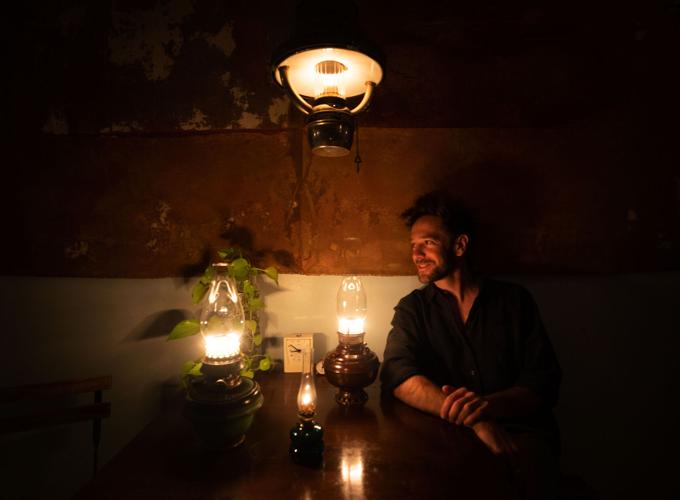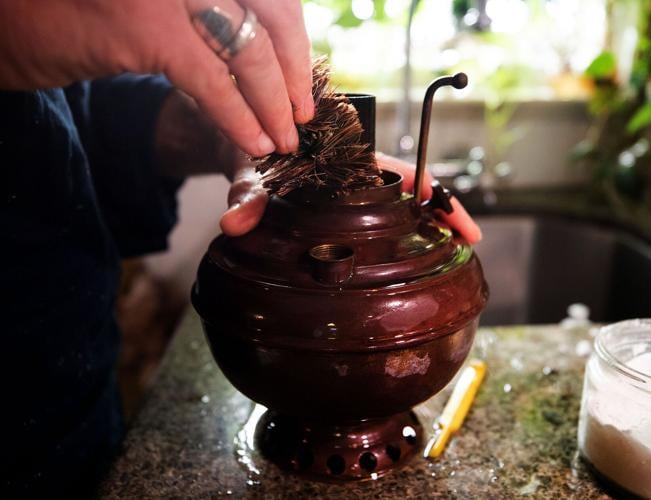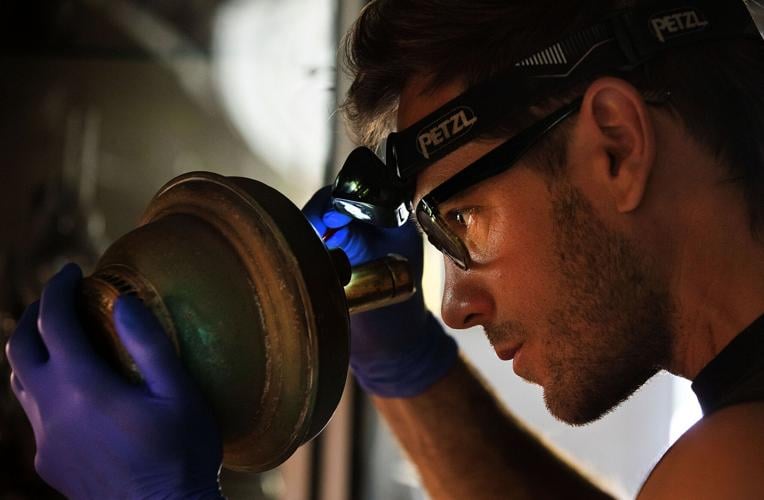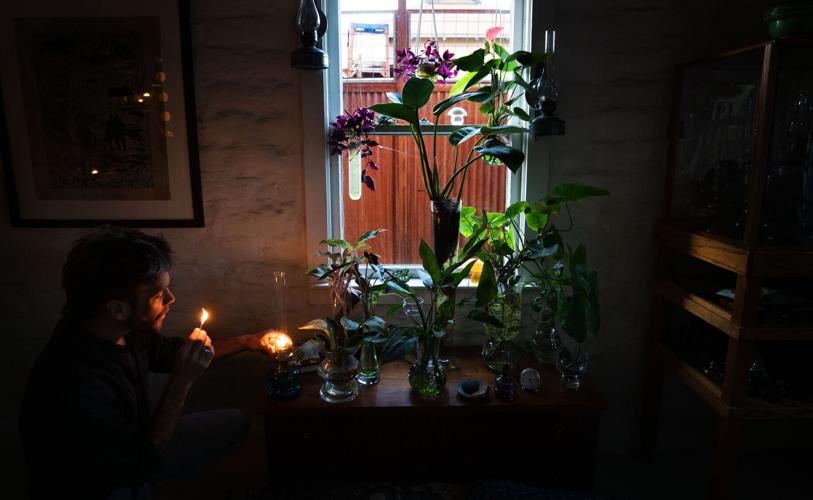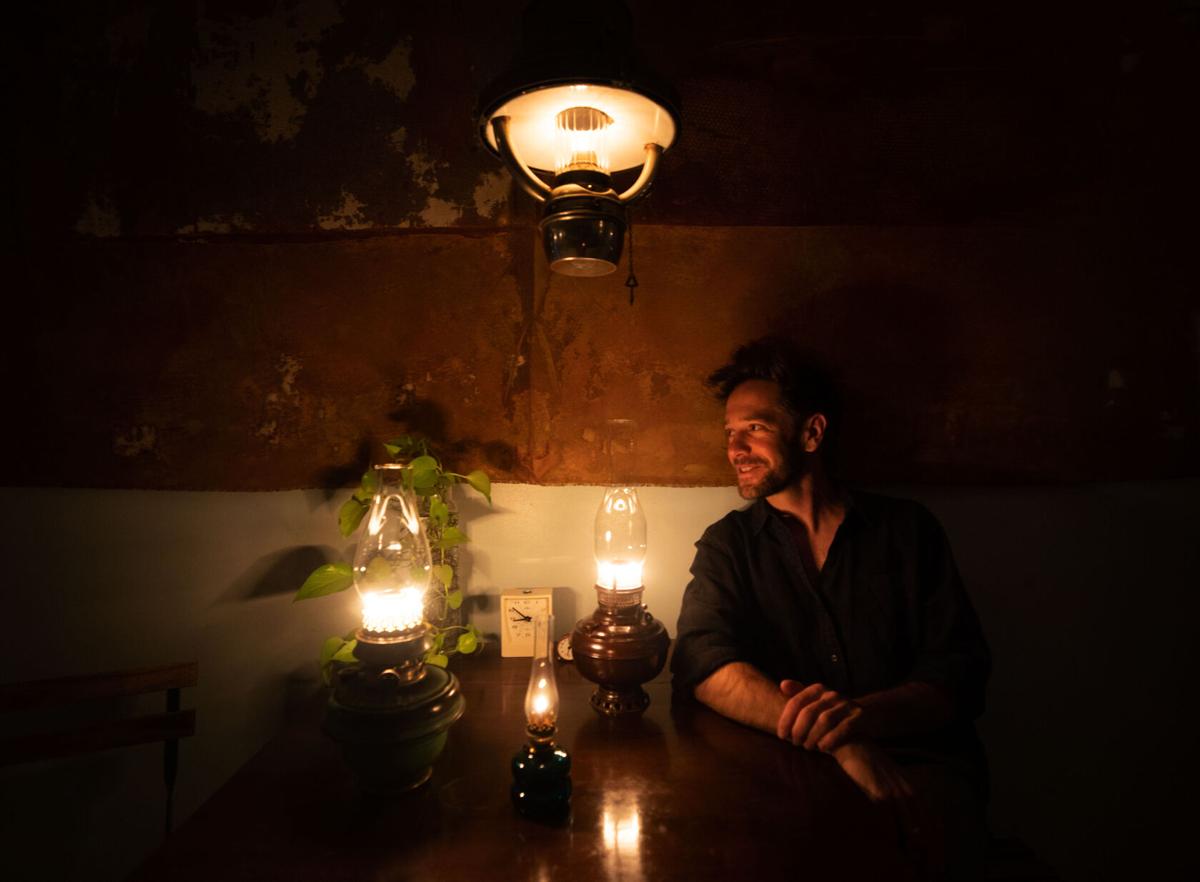Brett Tracy isn’t just living in the past, he’s basking in its glow.
If you stroll past the artist’s home in the Dunbar/Spring Neighborhood at night, you might see the warm flicker of lanterns in the window and above the front door. The row-house apartment has the usual complement of wall switches and electric light fixtures, but Tracy rarely uses them.
He chooses to illuminate his place the way it was probably lit when the adobe structure was first built in 1895: with kerosene lanterns, like the ones he has fashioned into functional objects of old-timey art.
“The quality of the light is the biggest thing for me. There’s nothing better than the light that comes from a flame,” he said. “We’ve been staring into campfires, into fire, since the beginning. We’re wired for that.”
Tracy started collecting and restoring old kerosene lamps a little over four years ago. Now his place is packed with them — or at least it used to be.
Earlier this year, Tracy hosted an exhibition and silent auction for his creations at his home near Ninth Avenue and University Boulevard. The Jan. 28 event, winkingly titled Keroscene, came with its own promotional postcards and a professionally made program filled with 40 pages of gallery-quality photographs and descriptions of the pieces on display.
Some 54 liquid-fueled lamps were sold that night, mostly to friends in Tucson, which is exactly what Tracy was hoping for.
“I could sell them on eBay all over again and send them out to some anonymous person. But if they stay in town, I’m more likely to see them at someone’s place, see them in use,” he said.
The proceeds from the auction basically covered the cost of the event, including the postcards, the programs and the open bar, Tracy said.
One lamp sold for $250. Ten others failed to sell at all because they were built with extremely rare parts and had to be priced accordingly.
A welcome ritual
Tracy prefers simple, well-used domestic models to the ornate, decorative Victorian lamps some people collect. He is especially drawn to plain, industrial lanterns made in the former USSR, some of which resemble grenades and come in a color Tracy refers to as “Soviet gray.”
“They are some of my favorites, because they’re so utilitarian,” he said.
To him, collecting old lamps like these is an extension of a larger critique of modernity that he has been engaged in for a long time now. “How, in this sort of cult of progress, we’re trained to adopt every new technology that’s handed to us without considering the effects on our experience of being alive,” the artist explained.
Of course, the convenience and omnipresence of electric light isn’t the only reason liquid-fuel lamp use has declined over the past century or so.
The World Health Organization considers kerosene a harmful pollutant, not safe for widespread household use. Smoke from burning the fuel is known to contain harmful particulates, and long-term exposure has been linked to higher risks of cancer, respiratory problems and other serious ailments.
“It’s not 100% clean, obviously. You’re burning a combustible thing, but it is highly, highly refined fuel,” Tracy said. “I had a carbon monoxide detector plugged in here for months that never read anything but zero.”
Using kerosene lamps can also be complicated and time consuming, especially compared to, say, flipping a light switch. To Tracy, though, the inconvenience is actually a selling point.

Brett Tracy blows out a match after lighting one of his kerosene lamps before sunset at his home in Dunbar Spring. “It's really remarkable in here when lots of them are lit,” Tracy said. “When we have company and stuff, we’ll light like 10 or 15 of them.”
He enjoys the effort it takes to fill, maintain and illuminate his lamps. “It’s very much a ritual each night,” he said.
Tracy stumbled into lamp collecting by accident.
When he moved into his historic home on Ninth about five years ago, he knew he wanted to light his “vintage space” with something other than traditional electric bulbs.
“I think we’re living in a time of just generally bad lighting options. They’re trying to sell us the most efficient bulbs possible, and we are losing more and more quality of light in terms of subtlety and beauty,” he said.
He started with homemade candles, but the beeswax was messy and expensive and cumbersome to keep properly lit. Then he bought his first kerosene lamp off eBay — a cheap, 1950s model he later transformed by changing out various parts.
“I realized that there was all kinds of room for building with components,” Tracy said. “Like finding an interesting burner and pairing it with a cool font (the fuel reservoir at the base), and just creating lamps that would have never existed before.”
Lamps with lives
He quickly discovered he had a lot to learn. The lamps he was buying often didn’t come with vital parts like wicks or the glass enclosures known as chimneys. He had to research where to get that stuff in the correct sizes and styles.
“There was a lot of trial and error. I ended up with a lot of spare parts, because stuff didn’t fit with other things,” he said.

Brett Tracy uses water, baking soda and brushes to clean a new Juno #2 kerosene lamp at his home. The lamp is pre-1900s.
His other rookie mistake was starting out with the wrong fuel — a paraffin lamp oil that produced a messy, dim flame. He said everything got cleaner and brighter once he switched to kerosene.
Tracy also had to learn the lingo. There is a whole glossary of terms used to describe different lamps and their anatomy, but he said he picked it up pretty quickly through the other collectors he was interacting with on eBay and elsewhere.
The fraternity of kerosene lamp collectors is small and scattered, and most of the people Tracy has met are a great deal older than him. They have taught him a lot, but they don’t necessarily share his artistic sensibility. He said most of them treat their lamps like museum pieces that should be meticulously restored with all-original parts and shined until they look brand new. He wants his roughed up a bit.

Brett Tracy uses a headlamp to see inside a Sherwoods Birmingham Centre draft lamp while he moves around epoxy to fix a tiny crack on the interior. The fraternity of kerosene lamp collectors is small and scattered, and most of the people Tracy has met are a great deal older than him. They have taught him a lot, but they don’t necessarily share his artistic sensibility. He said most of them treat their lamps like museum pieces that should be meticulously restored with all-original parts and shined until they look brand new. He wants his roughed up a bit.
“I’m interested in patina. I want to show that this thing has been around for a while,” Tracy said. “I like the record of its previous life.”
Even a little rust can be “charming,” he said, so long as it can be stabilized and doesn’t impact the lamp’s performance.
“I also want it to be functional,” he said. “Stuff prefers to be used. It doesn’t want to sit around and be just an object. It wants to do the thing that it’s made to do — in this case, make beautiful light for this space.”
Tracy isn’t living completely bulb-free. He does use some LED lights in his kitchen when he is preparing food or, ironically enough, working on one of his lamps.
Once he’s done, though, the wicks are lit and the electric lights go off. “In the evenings, it’s all lamplight,” he said.
At the moment, Tracy has about 30 lamps positioned around the apartment, but on most nights, he and his partner, Ashley, get all the light they need from four or five of the brightest ones.
Lighting the way
Kerosene currently sells for about $17 a gallon, and Tracy said he goes through four or five gallons of the stuff each month. He uses less fuel in the summer, when the days are longer, and more in the winter, when the lamps double as a heat source. “We light them all and run them high, and they warm the place up nice and toasty,” he said.
In his living room, there is a kerosene lamp hanging from the bottom of the ceiling fan where an electric light would normally be and another easy-to-light lamp mounted to the wall just inside the front door, so he can illuminate the room quickly without being blinded by electric lights if he comes home after dark.
The rest of the collection gets used on a rotating basis, except on special occasions when it’s all lamps on deck.
“It’s really remarkable in here when lots of them are lit,” Tracy said. “When we have company and stuff, we’ll light like 10 or 15 of them.”
The exhibition and auction in January marked the only time the entire collection has been illuminated at once — close to 100 lamps blazing away inside the apartment and in the yard out back.
Tracy described that event as the “thesis show” for his Tucson residency. “It was the culmination of like 3½ years of learning and working and collecting and curating.”
Auctioning off most of the collection also freed up space to “bring in some new types of lamps, keep learning and keep the restoration work up,” he said. “I’ve bought 12 lamps since the show.”
His plan is to build up enough of a collection again by 2025 to hold another exhibition, which he’s already calling the “Keroscene biannual.”
He thinks he could have as many as 100 lamps ready to sell by then.
“I’m trying to make a case for these objects,” Tracy said. “Of course I’m not going to fill every house in Tucson with a lamp, but that’s not the point. The point is to make an argument for a discarded technology, to show what we’ve lost.”


